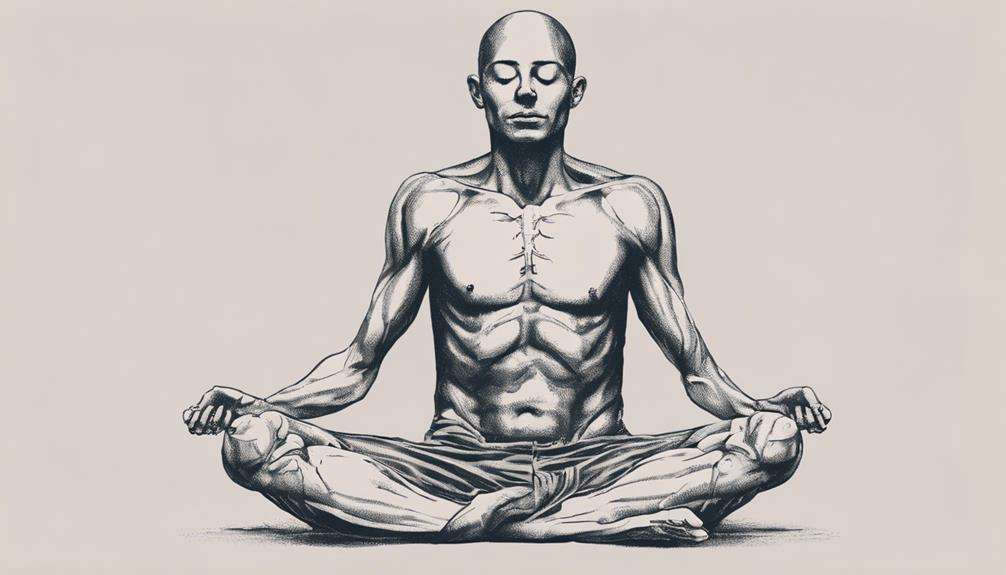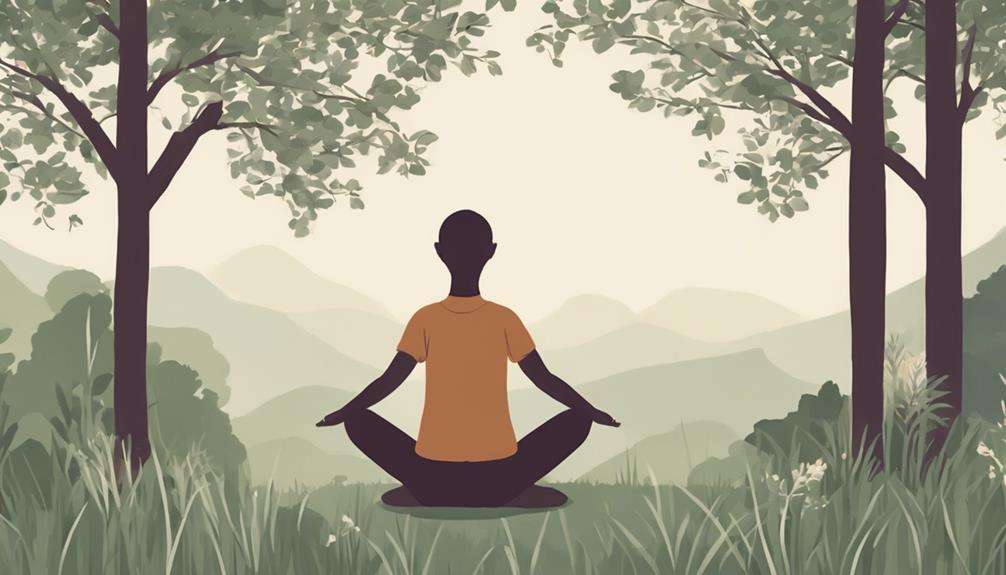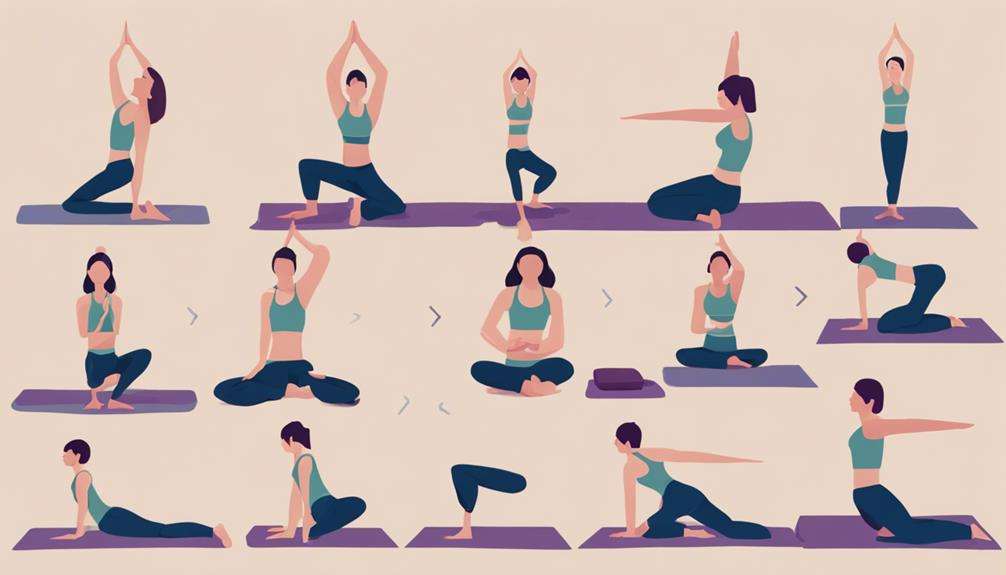Imagine your breath as the steady rhythm of ocean waves gently caressing the shore, bringing a sense of calm and clarity to your mind.
But what if this natural process could do more than just keep you alive?
Discover how specific breathing exercises can not only deepen your meditation practice but also elevate your overall well-being to new heights, offering a gateway to a more peaceful and balanced life.
Key Takeaways
- Practice diaphragmatic breathing during meditation for improved wellness.
- Explore advanced breathing techniques to enhance meditation benefits.
- Integrate breath work with meditation for a holistic mind-body experience.
- Choose suitable breathing techniques to elevate meditation practice and well-being.
Benefits of Pranayama for Wellness
Enhance your well-being through the transformative power of Pranayama, a sacred practice that nurtures the mind, body, and spirit. Pranayama, a form of breathwork deeply rooted in yoga, offers a myriad of benefits for your overall wellness. By incorporating Pranayama into your daily routine, you can effectively reduce stress and anxiety levels, promoting a sense of calm and relaxation within yourself. This ancient practice isn't only about breathing; it's a gateway to improving your respiratory functions, allowing you to breathe more efficiently and deeply.
Studies have shown that regular practice of Pranayama techniques can help manage symptoms of conditions like asthma and enhance lung capacity. Additionally, the connection between Pranayama and mental clarity is profound. By engaging in these intentional breathing exercises, you can sharpen your focus, improve emotional balance, and cultivate a deeper sense of mindfulness. Through the synergy of Pranayama and meditation, you can pave the way towards inner peace and a heightened state of well-being.
An Introduction to Diaphragmatic Breathing
Immerse yourself in the practice of diaphragmatic breathing, a foundational technique that fosters deep, belly breathing for relaxation and stress reduction. When you engage in diaphragmatic breathing, you aren't just inhaling and exhaling; you're connecting with a powerful tool for enhancing your overall wellness. Here are some key points to vital as you vital into this breath work:
- Embracing Calmness: Diaphragmatic breathing can help you tap into a sense of tranquility and peace within yourself.
- Stress Reduction: By activating the parasympathetic nervous system, this technique aids in lowering stress levels and promoting relaxation.
- Enhancing Health: Research suggests that diaphragmatic breathing may improve immune response and reduce hypertension, contributing to better physical health.
- Holistic Wellness: Learning diaphragmatic breathing allows you to bridge the gap between different nervous systems, fostering a sense of balance and well-being in your life.
As you explore the depths of diaphragmatic breathing, remember that each breath has the potential to bring you closer to a state of harmony and vitality.
Exploring Sama Vritti Pranayama Practice

Commence on a journey of inner harmony and mindfulness through the practice of Sama Vritti Pranayama, also known as Box Breathing. This breath work practice involves equal length inhalation, retention, exhalation, and pause, creating a rhythmic pattern that promotes balance and calmness.
By regulating the breath in a structured manner, Box Breathing can reduce anxiety, enhance concentration, and bring about mental clarity. Widely used in yoga and meditation, Sama Vritti Pranayama harmonizes the mind and body, fostering a sense of inner peace and tranquility.
Through this technique, stress levels can be diminished, relaxation can be achieved, and a deeper connection to oneself can be established. Embrace the power of Box Breathing to navigate the complexities of daily life with a newfound sense of serenity and centeredness.
Let the rhythmic flow of your breath guide you towards a more peaceful and balanced existence.
Nadi Shodhana Pranayama Technique Guide
As you explore the Nadi Shodhana Pranayama technique guide, you'll uncover the profound benefits it offers.
By learning the steps for this pranayama practice, you can experience a harmonious balance within.
Through the practice of Nadi Shodhana, you can cultivate inner peace and tranquility.
Benefits of Nadi Shodhana
Balancing your nervous system and enhancing relaxation can be achieved through the practice of Nadi Shodhana Pranayama, also known as Alternate-Nostril Yoga Breathing. This technique offers a myriad of benefits that can positively impact your overall well-being:
- Nadi Shodhana Pranayama helps to balance your mind and body, reducing stress and anxiety.
- By promoting relaxation, this practice can lead to a calmer state of mind.
- Regular practice of Nadi Shodhana has been linked to lower blood pressure and heart rate.
- The act of alternating nostril breathing can bring about a sense of inner peace and harmony within you.
Through these benefits, Nadi Shodhana Pranayama paves the way for a more serene and balanced existence.
Steps for Pranayama
Begin your journey into the tranquil kingdom of Nadi Shodhana Pranayama by mastering the fundamental steps of this ancient breathing technique.
Nadi Shodhana Pranayama, also known as alternate-nostril breathing, is a powerful practice for stress reduction, anxiety relief, and mental clarity.
To start, find a comfortable seated position. Using your right thumb, close your right nostril and inhale deeply through the left nostril. At the peak of your inhale, close the left nostril with your right ring finger, then release the right nostril and exhale.
Inhale through the right nostril, close it, and exhale through the left. This cycle forms one round.
Practice this technique regularly to balance your energy flow, enhance focus, and promote overall well-being.
Understanding Ujjayi Pranayama Benefits
Experience the profound benefits of Ujjayi Pranayama, a transformative breathing technique in yoga and meditation that fosters relaxation and mental clarity. Ujjayi Pranayama, also known as the Ocean Sounding Breath, involves slow, deep breathing through the nose with a slight constriction in the throat, creating a soothing sound that brings peace to the mind.
Here are some emotional benefits of practicing Ujjayi Pranayama:
- Calming the Mind: The rhythmic nature of this breathing technique helps to calm a busy mind, allowing you to find inner peace.
- Reducing Stress: By focusing on the sound of your breath, you can release tension and alleviate stress from your body and mind.
- Enhancing Concentration: Ujjayi Pranayama aids in improving concentration and mental focus during meditation and throughout the day.
- Promoting Relaxation: The deep, controlled breaths promote a sense of relaxation and well-being, rejuvenating both body and mind.
Embrace the power of Ujjayi Pranayama to nurture your emotional well-being and cultivate a sense of mindfulness in your daily life.
The Buteyko Breathing Technique Explained
Utilizing the Buteyko Breathing Technique involves focusing on nasal breathing to reduce hyperventilation and enhance oxygen delivery through controlled breath patterns. This technique, developed by Russian doctor Konstantin Buteyko, emphasizes breath control to increase carbon dioxide levels in the blood, ultimately correcting dysfunctional breathing patterns. By practicing slow, shallow breaths and incorporating breath-holding techniques, individuals can experience the potential benefits of improved respiratory function.
Research suggests that the Buteyko Breathing Technique may be particularly beneficial for individuals dealing with asthma, anxiety, and sleep disorders. By consciously regulating the way you breathe, you can positively impact your overall well-being and address specific health concerns. Through consistent practice and mindfulness, this technique offers a natural and accessible way to support respiratory health and promote relaxation.
Embracing the principles of the Buteyko Breathing Technique can empower you to take control of your breathing patterns and cultivate a sense of peace and balance within yourself.
Laughter Yoga for Improved Breathing

Embrace the harmonious connection between laughter and breathing with Laughter Yoga, a practice that intertwines intentional laughter and deep breathing to enhance both respiratory function and emotional well-being. Laughter Yoga sessions are designed to stimulate your diaphragm, encouraging deeper breathing patterns that can benefit your overall well-being. Here are some key points to ponder about Laughter Yoga:
- Engage in intentional laughter to improve respiratory function and mood.
- Practice playful activities that promote deeper breathing and relaxation.
- Experience the benefits of increased lung capacity and oxygen levels in the body.
- Embrace the potential for reduced stress, enhanced immune function, and overall well-being through regular Laughter Yoga practice.
Through the combination of laughter exercises and deep breathing techniques, Laughter Yoga offers a unique way to improve your breathing patterns while uplifting your spirits.
Allow yourself to explore the joy and benefits that arise from this practice, nurturing both your body and mind.
Heart Rate Variability Biofeedback Benefits
Enhance your well-being through the benefits of heart rate variability biofeedback, a practice that focuses on measuring the variation in time intervals between heartbeats to assess autonomic nervous system function. By incorporating breathing techniques, heart rate variability biofeedback becomes a powerful tool for self-regulation and stress management. Research indicates that this practice can meaningfully improve emotional regulation, cognitive performance, and physical health outcomes. Through training individuals to control their heart rate variability, biofeedback aids in reducing anxiety, depression, and symptoms of PTSD.
Engaging in heart rate variability biofeedback with proper guidance can lead to enhanced cardiovascular health, emotional resilience, and stress reduction. By utilizing this technique, you can actively participate in managing your well-being, fostering a sense of control over your physiological responses. Embracing heart rate variability biofeedback offers a pathway towards improved self-regulation and a more balanced emotional state. It serves as a valuable tool in promoting holistic wellness by harmonizing the mind-body connection.
Integrating Breath Work With Meditation

To deepen your practice of heart rate variability biofeedback, contemplate integrating breath work with meditation for enhanced relaxation and focus. When merging breathwork and meditation, you open yourself up to a world of possibilities for improving your emotional well-being and overall wellness.
Here are some key points to contemplate:
- Diaphragmatic Breathing: Engage in deep diaphragmatic breathing to calm your nervous system and center your mind during meditation.
- Mindful Breathing Techniques: Explore various mindful breathing techniques to enhance your focus and cultivate a sense of presence in the moment.
- Stress Reduction: Use breathwork in meditation to reduce stress levels and create a deeper sense of relaxation within yourself.
- Emotional Well-Being: Incorporate breath awareness into your meditation practice to nurture your emotional well-being and promote inner peace.
Integrating breath work with meditation can truly transform your mindfulness practices, offering you a path towards greater relaxation, focus, and emotional balance.
Tips for Choosing Your Breath Work Practice
Consider your wellness goals carefully when selecting a breath work practice that aligns with your needs and preferences. Explore various breathwork techniques such as diaphragmatic breathing or alternate-nostril breathing to determine which resonates best with you.
Look for practices that you feel drawn to and can engage with consistently. Seeking guidance from a qualified instructor or resources can provide personalized recommendations tailored to your specific wellness objectives. Remember to experiment with different methods to discover what enhances your meditation experience.
Frequently Asked Questions
What Are the Best Breathing Exercises for Meditation?
When looking to enhance meditation, focus on deep, diaphragmatic breathing. Explore techniques like box breathing, alternate nostril, belly breathing, 4 7 8 breathing, breath awareness, and ocean breath. Embrace these practices for a mindful and balanced journey.
What Are the Spiritual Benefits of Breathing Exercises?
Engaging in breath work can enhance your spiritual journey. It fosters mind-body harmony, promotes energy flow, and cultivates inner peace. Breathing exercises deepen your spiritual connection, provide emotional balance, and offer healing power, stress relief, and self-awareness.
Which Breathing Exercises Help to Control Mind?
Take deep breaths, focus on mindful inhales, and slow exhales. Engage in controlled breaths, creating relaxing rhythms. By practicing these techniques, you can cultivate a calm mind and peaceful practice, enhancing your overall well-being.
Can Meditation and Breathing Exercises Sharpen Your Mind?
Enhance mental clarity, focus, and cognitive function through meditation and breathing exercises. Reduce stress, improve energy, and balance emotions. Boost creativity, sharpen memory, and nurture a sharper mind with the synergy of these practices.
Conclusion
As you continue your journey of mindfulness through breath work and meditation, remember the power of each inhale and exhale. Just like a gentle breeze can stir the leaves of a tree, your breath can bring peace and clarity to your mind.
Embrace the rhythm of your breath, let it guide you towards a place of calm and balance. In this symphony of life, may your breath be the conductor of your inner harmony.






